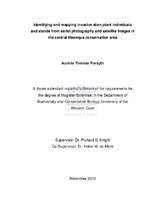| dc.description.abstract | The Cape Floristic Region, situated at the southern tip of Africa, is one of the world’s most botanically diverse regions. The biodiversity of this region faces various types of threats, which can be divided into three main categories, namely increasing urbanisation, agriculture expansion, and the spread of invasive alien vegetation. It has been shown that botanically diverse areas are more prone to invasion by invasive alien plant (IAP) species. The Hawequa conservation area, in the south-western Cape, is particularly botanically diverse, such that it is very prone to aggressive invasion by IAP species. Therefore, conservation management of the Hawequa conservation area urgently need to map, prioritise and clear IAP species. Due to the topographical complexity of this mountainous area, it is not possible to map the distribution of IAP species throughout the protected area by conventional field methods. Remote sensing may be able to provide a suitable alternative for mapping. The aim of this research was to assess various image classification methods,using two types of high-resolution imagery (colour aerial photography and WorldView-2 satellite imagery), in order to map the distribution of IAP species, including small stands and individuals. Specifically, the study will focus on mapping Pinus and Acacia spp. in a study site of approximately 9 225ha in the Hawequa conservation rea. Supervised classification was performed using two different protocols, namely per-pixel and per-field. For the per-pixel classification Iterative Self-Organising Data Analyses Technique (ISODATA) was used, a method supported by ERDAS Imagine. The per-field (object-based) classification was done using fractal net evolution approach (FNEA), a method supported by eCognition. The per-pixel classification mapped the extent of Pinus and Acacia spp. in the study area as 1 205.8 ha (13%) and 80.1 ha (0.9%) respectively, and the perfield classification as 1 120.9 ha (12.1%) and 96.8 ha (1.1%) respectively. Accuracy assessments performed on the resulting thematic maps generated from these two classification methods had a kappa coefficient of 0.700 for the per-pixel classification and 0.408 for the per-field classification. Even though the overall extent of IAP species for each of these methods is similar, the reliability of
the actual thematic maps is vastly different. These findings suggest that mapping IAP species (especially Pinus spp.) stands and individuals in highly diverse natural veld, the traditional per-pixel classification still proves to be the best method when using high-resolution images. In the case of Acacia spp., which often occurs along rivers, it is more difficult to distinguish them from the natural riverine vegetation. Using WorldView-2 satellite images for large areas can be very expensive (approximately R120 per km2 in 2011), but in comparison with the cost of mapping and the subsequent clearing, especially in inaccessible areas, it might be a worthwhile investment. Alternative image sources such as the high resolution digital colour infrared aerial photography must be considered as a good source for mapping IAP species in high altitude areas. | en_US |

